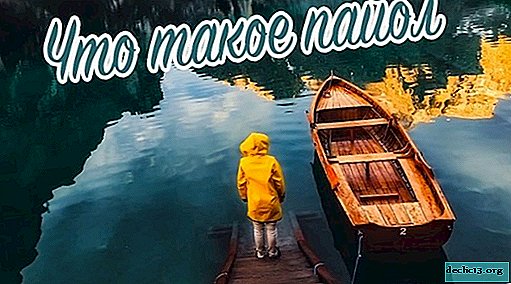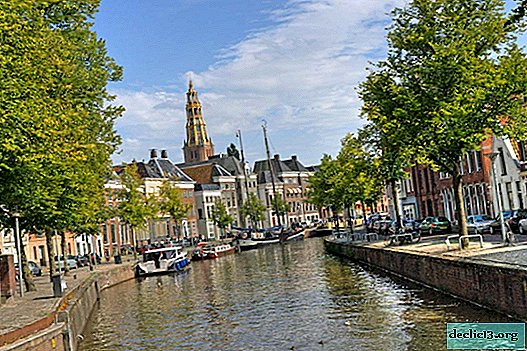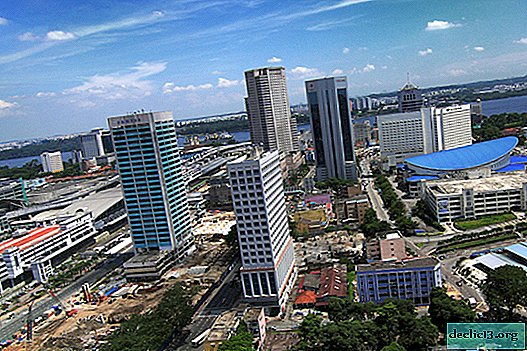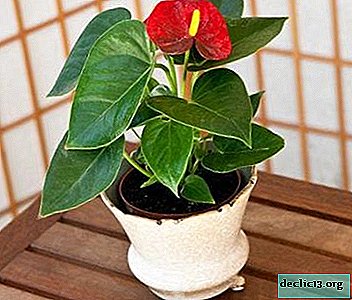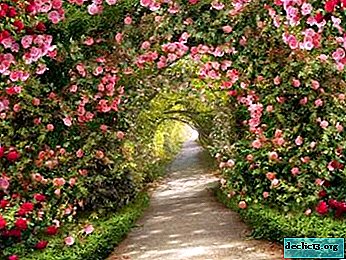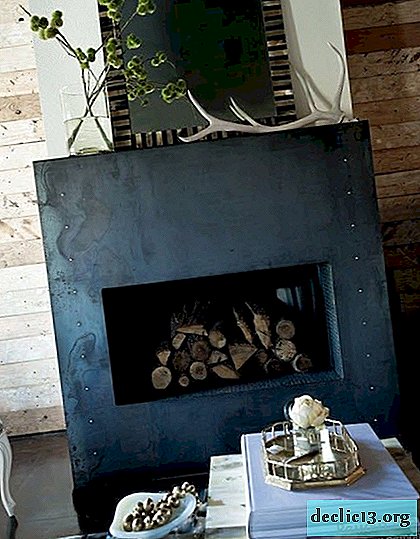Beautiful Rhododendron Rosie Lights: Interesting and Important Information About This Deciduous Shrub
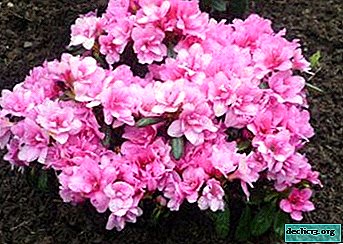
The North American variety Rosie Lights attracts lovers of exotic flowers with its winter hardiness and picturesque purplish - pink flowering.
Belongs to a large genus of deciduous rhododendrons of the Vereskov family.
In the article, we learn in detail what this type of rhododendron is (what it looks like), and also consider how to use a flower in landscape design and how to care for Rosie Lights.
Brief definition
Rosie Lights from a series of hybrid varieties from the Knapp-Hill-Exbury group is considered the most frost-resistant. Varieties bred in North America, Minnesota.
Detailed description
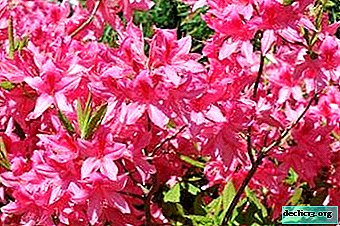 Rosy Lights - deciduous shrub, grows up to 1 - 1.5 m tall.
Rosy Lights - deciduous shrub, grows up to 1 - 1.5 m tall.- The bush is sprawling, branches well, branches are erect.
- The leaves are oblong, concave, lanceolate, the tips of the leaves are sharp. The color of the leaves is light green with a yellowish tinge. In autumn, the leaves change color, become dark burgundy.
- The flowers are large, funnel-shaped, up to 6 cm in diameter, wavy petals at the edges. The color is saturated - pink, with orange spots - interspersed.
- Inflorescences are dome-shaped, combine 8 flowers each.
- The buds ripen in late May - early June.
- The root is flat, superficial.
History of occurrence
The history of breeding a series of rhododendrons Light began in the 30s of the 20th century, in the United States. Over time, more than 10 varieties of frost-resistant hybrid deciduous varieties were bred in the arboretum of North American University of Minnesota.
Azalea Rosie Light was bred in 1984. In modern breeding, work continues on a project for breeding frost-resistant exotic flowers.What is the difference from the rest of the species?
- Rhododendron Rosie Lights has a strong fragrant aroma.
- The bush lends itself well to pruning and crown formation.
- It easily survives in open ground, it winters well even in large frosts.
Subcort
Mandarin Lights
- Deciduous shrub.
- The height of an adult bush reaches 2 - 2.5 m. The crown extends to a width of up to 2 m, rounded.
- The leaves are large, long, grow up to 10 cm, oblong, sharp at the ends, wedge-shaped at the base. In summer, the foliage is saturated olive color, in the fall they become deep burgundy.
- Flowers of a colorful red - orange hue, an orange spot stands out on the central petal. In shape, the flowers are narrow, bell-shaped, with wavy edges, medium in size, with a diameter of 5 - 6 cm.
- The root system is superficial; when planting, it does not require much deepening.

Golden Lights
- Decorative deciduous bush grows to 1.5 - 2 m. It blooms from mid-May, belongs to the early varieties.
- The bush is compact, the form is straight and loose, with age the bush thickens, grows in the hemisphere.
- The crown is wide, in diameter reaches up to 1 - 1.5 m.
- The leaves are oblong, wide, up to 6 cm, pointed at the ends, 10 cm long. The leaves are wedge-shaped at the base.The color of the leaves is unusual - olive - green, in autumn the leaves change color, become saturated bright - burgundy. In winter, the leaves fall.
- Stems - shoots branch well.
- The flowers are salmon-orange, funnel-shaped, medium in size, up to 5 cm in diameter. The throat of the flower itself is lighter than the edges of the petals, have a pink tint.
- Inflorescences form large bouquets, in each inflorescence gathers up to 8 - 10 flowers.

Bloom
When and how?
Rhododendron Rosie Lights blooms in early summer lush rounded inflorescences - brushes of raspberry flowers.
Care before and after
Rhododendron Rosie Lights in the flowering period needs good light and plentiful, regular watering. During the ripening of flower buds, the temperature should be reduced, not exceeding 15 - 17 ° C. After flowering, the elongated shoots are cut for propagation by cuttings.
Faded buds and flowers should be removed immediately after flowering.What to do if it does not bloom?
Rhododendron Rosy Lights slows down its development and flowering, if planted in the shade, it needs good lighting without direct sun. It is necessary to fertilize the substrate with mineral or special complex fertilizing for azaleas. Perhaps you should acidify the soil or change the composition of the substrate, supplementing it with the necessary components.
Use in landscape design
Rhododendron Rosie Lights looks harmoniously in rockeries among the rocky compositions. Decorates gardens and park alleys. Perfectly adjacent to conifers - pines, juniper. This variety is used in the creation of mixed multi-tier mixborders.
Step-by-step care instructions
Seat selection
Rhododendron Rosie Lights is photophilous, but the bright sun can leave burns on the leaves, so flowers are planted in semi-shady places. It grows well in the scattered shade of pine and spruce or other deciduous trees. Habitats should be secluded, protected from gusts of wind and drafts.
What should be the soil?
 Rhododendron Rosie Lights grows only in acidic, loose, humus-rich soils.
Rhododendron Rosie Lights grows only in acidic, loose, humus-rich soils.
The composition of the soil mixture:
- sheet land - 3 hours
- high peat - 2 hours
- coniferous tree litter - 1 hour
You can use another option:
- turf land - 1 hour
- sphagnum peat - 4 hours
- coarse sand - 1 hour
Mandatory weeding of weeds is mandatory, mulching the soil around the trunk with a layer of 7 - 9 cm thick.
Landing
Rhododendron Rosie Lights landed in the spring, the procedure is not complicated:
- Dig a deep hole, 50 cm deep, with a diameter of 70 cm.
- A drainage consisting of broken slate, brick and sand with a layer of 10-15 cm is laid at the bottom.
- The pit is filled with a special substrate.
- Planting bush is placed vertically, deep deepening is not required.
- Fall asleep with a soil mixture at the level of the root neck.
- Around the trunk is necessarily mulching.
Temperature
Rhododendron Rosie Lights is characterized by high winter hardiness, resists frosts up to 40 ° C. This variety prefers a humid cool climate; the optimum growth temperature is -12 - 15 ° C. In the summer heat, morning spraying of the bush is mandatory. The flower does not tolerate drought.
Watering
Rhododendron Rosie Lights loves moisture, but excessive moisture can lead to waterlogging of the substrate and fungal diseases of the root and stems. In summer, watering should be daily, at the rate of 8 - 10 liters per bush. In the autumn, before wintering, the bushes are abundantly watered, then watering is reduced, the substrate should be moistened only in dry weather.
Top dressing
Fertilizers are introduced from the very beginning of flowering with special mineral top dressing - superphosphate, potassium sulfate, ammonium. Two months before frosts, re-fertilize the substrate with potash and phosphorus fertilizers in a ratio of 1: 2.
Pruning
Rosie Lights Rhododendron is pruned in early spring or fall. They cut off too long last year's shoots by a third. Dry flowers and buds are also cut for further laying of buds.
Attention! Slices after sanitary pruning must necessarily be treated with garden varnish or paint on varnish.Transfer
Rhododendron Rosie Lights endure transplant, but it is important not to deepen the root neck, it can rot. Florists recommend placing the transplanted bush so that the root neck rises above the substrate level by 1.5 - 2 cm. When transplanted, the substrate is slightly compacted. The composition of the substrate must necessarily include coarse sand. Mulch trunks circles 2 times a year, adding coniferous bark or fallen conifer needles.
How to propagate?
 Rhododendron Rosie Lights are well propagated by seeds:
Rhododendron Rosie Lights are well propagated by seeds:
- Sowing is carried out in April.
- Germinate seeds should be in a cool room at a temperature of 15 ° C.
- Seeds are sown in a sand - peat mixture.
- Humidification should be regular.
- The first leaves need to be dived and kept in a greenhouse.
- Seedlings bloom only for 5-6 years of cultivation.
Variety Rosie Lights can be propagated by cuttings:
- Cuttings are cut with a length of 7 - 9 cm.
- Leaves should be left on top of the handle.
- Before planting, the cuttings are lowered for a day in a solution with any root growth stimulator.
- Cuttings are planted in a ready-made special substrate for rooting.
Diseases and Pests
The most common diseases of Rhododendron Rosie Lights: root rot, rust, leaf spotting - spraying of the substrate and bushes with Bordeaux fluid is required.
The flower can be damaged by pests:
- From a mealybug, a rhododendral bug, spraying with any insecticides - actar or phytoverm helps. A soap solution will help get rid of the spider mite.
- From scabs, ticks, spraying karbofos will help.
- To get rid of weevil, you need a solution of diazonin. It is necessary to process the branches, leaves, substrate around the bush.
Prevention of various problems
- If the Rosie Lights Rhododendron does not have enough light, the shoots are very elongated, flowering slows down. It is better to transfer the flower to a more lighted place.
- If the leaves turn yellow, you need to fertilize the flower with iron chelate.
- Rotted shoots must be immediately cut off so that the infection does not spread.
- Heavily damaged bushes need to be discarded.
Rhododendron Rosie Lights is a whimsical exotic flower that develops well and blooms generously only if all the features of caring for it are observed.

 Rosy Lights - deciduous shrub, grows up to 1 - 1.5 m tall.
Rosy Lights - deciduous shrub, grows up to 1 - 1.5 m tall.


